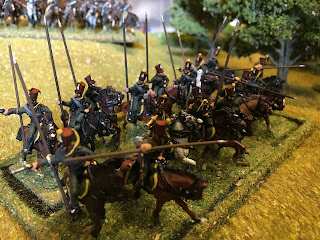Losses at the end of Day 1 were roughly even:
French losses: 14 battalions, 2 foot batteries, 6 regiments of cavalry.
Allied losses: 17 battalions, 2 foot batteries, 3 regiments of cavalry, 2 horse artillery batteries.
The Austrian commander was replaced by another attendee but all those who had commanded on day 1 would be holding their commands for day 2. The French had managed to hold Stehlen, the barn in Bachnitz but had lost the manor house in Plauen so the artillery arsenal was split 10 rounds of effective fire to the French and 5 to the Allies for redistribution.
The Allies never did take a look behind that hill and wood screen and so it remained, would the newly constructed pontoon be useful for potential reinforcements?
French reinforcements.
Two divisions of French infantry. (2 brigades of Old Guard, 2 brigades of Young Guard, one line brigade and one conscript brigade) Four foot batteries. One cavalry Division of 3 brigades plus 2 horse artillery batteries. Lots to welcome.
Using the 1D8: (thrown 3 x for each division)
Infantry:
1: does not arrive.
2: deploys on the western flank.
3-7: deploys in the centre.
8: Deploys eastern flank.
The French threw a 5 (Guard) and an 8. (Handy for the Guard to arrive in the middle)
Cavalry:
1: does not arrive.
2: Deploys western flank.
3-5: centre.
6-8: eastern flank.
The French threw a 2. Looked like that pontoon bridge would come in handy after all.
 |
| Day 2. The map is missing the 2nd Austrian heavy cavalry brigade which punched a hole between the Austrian Grenadiers and the 6th Hungarian brigade on the eastern flank. |
Western flank:
The Prussians were already having problems on the western flank and now with cavalry coming at them from the village and across the pontoon, desperate measures were needed.
 |
| Two regiments of Guard scouts and a regiment of heavy dragoons (4th cavalry brigade) begin to outflank the Prussians using the pontoon. |
 |
| Art Miniaturen. Guard scouts with their newly acquired shakos. |
 |
| The 1st and 2nd French cavalry brigades move towards the relief of Plauen. Carabiniers, Horse Grenadiers and Krakus Cossacks leading the way. (just visible crossing the bridge) |
 |
| The Prussian 4th brigade that never saw action. Being left behind it lacked the will to move forward when it mattered. Should have been used on day 1. |
 |
| The cavalry clash in the centre using the newly deployed Prussian 2nd brigade and Austrian dragoons. French cuirassiers of the 3rd brigade blocked the way however. |
 |
| Prussian landwehr were no match for the Old Guard in Bachnitz. |
 |
| Prussian light cavalry made little impact but would at least provide some cover for an eventual withdrawal. |
 |
| Silesian cavalry watching…. |
 |
| 1st Lieb Hussars….also did a lot of watching. |
The Prussians began to withdraw their infantry while their cavalry sat and witnessed the debacle.
Eastern flank:
To cap it all, the new Austrian commander threw a succession of 1s, 2s and the odd 3 on the D8 which meant he could not get his troops moving to take advantage of the lull, before the French reinforcements could make a real difference. The heavy fighting on the previous day had clearly taken its toll. The Austrians simply could not take advantage of the lack of French cavalry and lacked guns that constantly had to limber up when the brigade they belonged to kept failing its test.
 |
| Austrian cavalry attempt to make a go of it but the woods prevented the space to attack. |
The Austrians did manage to take one building in Strehlen before yet another failed brigade test meant they had to vacate. Austrian brigades began to disintegrate, though one sole Austrian heavy cavalry brigade caused a minor flutter of hearts amongst the Allied camp. The Austrian Grenadiers eventually ran out of steam also.
 |
| 3 out of 6 Austrian Grenadier battalions begin to run out of steam. Austrian cuirassiers from the 2nd brigade did initially make an impact before their infantry colleagues began to retire. |
 |
| The Austrian 6th brigade failing to make progress having crossed the stream. One battalion was wiped out by a flank attack from Bavarian light infantry. |
 |
| The Allied losses. Immense. So immense in fact that I could not be bothered to count them. |
 |
| French losses by the end were not greatly different from those at the end of day 1. A few more cavalry regiments. |



No comments:
Post a Comment